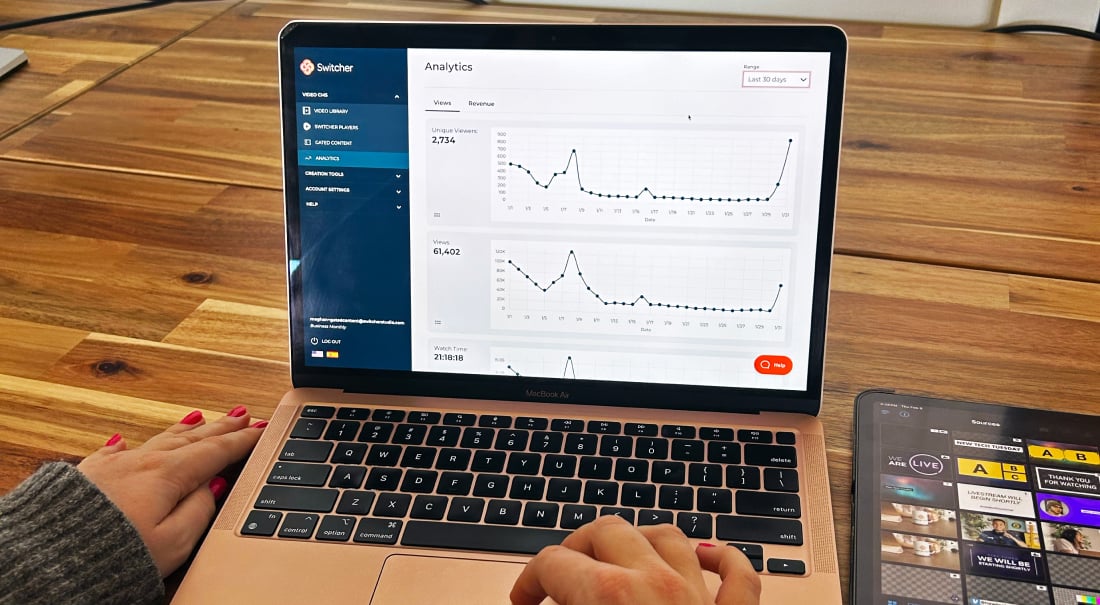
These days, being a marketer (or content creator) is about more than just creativity.
Digital marketing is a fast-moving, competitive, and highly iterative field. Beyond simply creating great video content, successful marketers know how to mine key metrics, interpret data, and act on those insights. In other words, understanding video marketing analytics makes for better video marketing.
This ultimate guide to video marketing analytics will cover the basics — what different metrics mean and how to use them — plus recommendations for analytics tools to help hone your content strategy. So whether you’re building brand awareness, trying to foster audience engagement, or simply learning a new skill as a marketer or content creator, let’s get started.
Why do video marketing metrics matter?
If you’re new to the world of video marketing, you might be wondering why metrics are so important. There are a few key reasons.
Analytics offer insights into your audience
One of the most exciting aspects of marketing in 2024 is the speed with which we can learn from our audiences. That means real-time insights into age and location, likes, dislikes, behaviors, and more. This kind of data feedback is vital for content marketers to learn about target audiences and better tailor video content.

Metrics allow marketers to measure performance
Additionally, video marketing analytics allows marketers and creators to measure video performance. That means a range of data points related to overall popularity, engagement, conversions, and so on. With this kind of data, marketers can measure and maximize ROI (return on investment) for their video content. They can also optimize content, and make more informed decisions about future video releases or campaigns.
Optimizing content, and content strategy, leads to better outcomes
If you understand video marketing metrics and use these numbers to track your video success, you can better understand what video works for your audience and your brand. Then you can make adjustments to your content and make more strategic decisions for your next campaign.

Video marketing analytics means understanding what your target audience wants and what content works.Armed with that data, you can improve and optimize your videos — topics, titles, thumbnails, format, orientation, length, cadence, messaging, CTA, platform, and more — creating the most targeted and effective content possible.
Learning from video analytics
For most video creators and content marketers, learning from video analytics is an ongoing iterative process.
Of course, before you create your first video, you’ll want to do some pre-work. Research your target audience, establish your niche, and identify your goals. Maybe you want to drive awareness around an organization, perhaps you want to drive sales, or maybe you’re just building an audience so you can one day monetize your content.
No matter what your goals are, it’s important to outline them. Before you start learning from your video analytics, you need to know what you’re working towards.
Create video and publish video content
Begin creating and publishing your video content. The format and platforms you start with could depend on your target audience and goals. (Trying to reach an audience of young adults? Go for TikTok over Facebook.) However, the broader you cast your net, the more data you’ll have to learn from.

Analyze content performance
Once your content is live, you can begin exploring your analytics right away. The metrics you have access to may vary, but you should be able to gauge popularity and engagement on almost any video platform. Identify high-performing videos, and try to identify common themes, whether it’s the topic, format, or production value. And remember — what works on one platform might not work on another, and vice versa.
Refine and test your content
Once you’ve identified some commonalities, apply those learnings to your next round of videos.

Maybe you saw great engagement from a vertically oriented and unscripted video, but low engagement from a highly scripted and produced video. It’s fair to assume that your particular audience prefers more authentic content. So what now? Try creating and testing one or two more unscripted vertical videos. You could even recreate the content from the low-performer in a more casual format to see if it performs better.
Take note of each improvement in your video performance, and track your learnings.
Stay nimble and consistent
As I mentioned, this process of testing and iterating should be ongoing. Not only because it will steadily improve your content, but also because video marketing is a dynamic landscape.
Changes in trends, platforms, algorithms, and consumer behavior can influence your video performance, so it’s important to analyze your metrics regularly, and always be ready to try new approaches.
As I mentioned before, your specific analytics reporting may vary depending on your platform, but let’s start with an overview of key video marketing metrics.
View count
One of the most basic video marketing metrics is also one of the most important for creators and marketers: views.
Video views are the total number of times your video has been watched (though not necessarily through to the end — more on that shortly). You can also measure channel views on most platforms, meaning the total number of views across all of your shared videos.

Views indicate that your video is compelling enough for your audience to press “play,” so your total number of video views is a quick and easy gauge for general content success. Similarly, channel views are a good way to benchmark your overall content strategy: If you see a huge spike or dip in views, it’s worth investigating further.
Ideally, you can use views to start pinpointing and replicating winning video strategies.
Watch time
Video watch time is another key data point when it comes to measuring video success. Beyond just “how many times was a video viewed,” watch time answers the question “how much time are viewers spending watching my content.”
Marketers can measure a video’s total watch time or average watch time.
-
Total watch time refers to the total amount of time a video has been watched, across viewers.
-
Average watch time is the total watch time divided by the number of views.
On many platforms, you can also see total channel watch time, i.e., watch time across all posted videos.

Generally, video watch time, like video views, can broadly signal content success. A high number is a good sign. And, beyond a general pulse of your channel, watch time metrics can also signal when you should dig deeper into your analytics tools.
Depending on the platform you’re using to host your video, watch time metrics can also directly influence your content’s performance. On platforms like YouTube, high watch time also signals the algorithm, so videos are more likely to be recommended to new viewers. This is great for discoverability, and creators should take note of what videos have high watch time, and why.
On YouTube, creators need to have 4,000 watch hours on their channel before they can monetize with advertisements through the YouTube Partner Program. It’s no wonder increasing video watch time is such a popular goal for new video creators!
Completion rate
Completion rate metrics indicate how many of your video viewers watch your video through to the end. A high completion rate indicates that your video is captivating from start to finish, which is exactly what you want.

Comparing videos with a high completion rate and videos with a lower completion rate may help you identify themes — what content keeps viewers locked in and what doesn’t? Average completion rate is an easy metric to calculate too, as long as you have access to your view count and the number of viewers who completed the video.
Average completion rate = (the number of viewers who completed the video/total video view count)×100%
Audience retention
Audience retention is a metric that may mean different things depending on the platform (or which marketer you ask).
-
Some consider audience retention to be the percentage of a video watched. In other words: An audience retention rate of 50% means that viewers are, on average, watching your video halfway through — whether that video is 10 minutes long or 10 hours long.
-
Other platforms use audience retention to describe audience engagement throughout the video. That means not just how much of the video was played, but where your audience engaged with or lost interest in your video.

In both cases, audience retention correlates closely with other metrics like watch time, and it’s worth digging into this data to pinpoint what’s working for you.
Plus, as with watch time, audience retention can impact the algorithm on social video hosting sites. Platforms like YouTube really, really want viewers to spend more time watching videos. So higher audience retention is a good thing for getting the algorithm to recommend your video, increasing views. (Not to mention that higher audience retention means higher watch time.)
It’s important to note that it’s rare for most viewers to watch (or engage with) a video to the end, even though you’ve put a lot of effort into the final product. So don’t be discouraged by low average video watch time or audience retention rates (or rest on your laurels when numbers are high). These metrics help to benchmark your videos so you can see what works and what doesn’t.
Exit points
Unless you have a unicorn audience who watches every video — closely — from start to finish, you’ll have moments during your video where your viewers disengage or leave. These are your video exit points.

If you’re trying to increase watch time or audience retention, reviewing and analyzing your exit points is key. Where do you see audience interest wane, and what’s on-screen at that moment? Look for changes in production quality, pacing that drags, disjointed storytelling, and so on. Note the themes that cause a drop in viewership, and then use that information to refine your pacing, delivery, and production.
Demographics
Demographic data refers to statistical information about your audience — things like age and location. Metrics around demographics can help marketers better understand, and reach, their target audiences.

The extent to which you can view demographic data may vary, but statistics like gender, geography, device type, and when your viewers are online, are fairly commonplace across platforms. This data can help inform audience segments, allow marketers to better target the right viewers, and make it possible to personalize content to boost engagement.
Engagement metrics
On social media, engagement metrics include likes, comments, and shares. High engagement numbers (especially comments and shares) are your goal when sharing videos on social media. High engagement boosts visibility — not just because your video is being shared with new viewers — but also because social platforms want to promote videos that get a lot of interaction.

For the video creator or video marketer, engagement metrics can demonstrate which videos are truly resonating with your audience and which are just noise. Particularly with video ads, honing your storytelling can seriously help boost emotional responses to your content, which naturally boosts engagement rates.
Click-through rate (CTR)
Click-through rate (or CTR) is another important engagement metric. Your video CTR is the ratio of viewers who click on a video compared to the number of people who see the video thumbnail. CTR can also refer to the ratio of viewers who click video links (such as a call-to-action button or a hyperlink) to the total number of viewers who were shown the link.

There are plenty of ways to improve your click-through rate and visibility on video hosting platforms, and it’s well worth the effort. After all, if no one is clicking your video, no one is watching or engaging with your content, and your capacity to optimize is seriously limited.
Video marketing analytics tools
Now that you know the most important video metrics, let’s take a look at some of the best video marketing analytics tools to help streamline and improve your reporting process.
YouTube Studio
We’ve talked a lot about YouTube-specific metrics, and as the native analytics platform for YouTube, YouTube Studio is the place to go for real-time insights into your video and channel performance.
In YouTube Studio, you can find robust metrics around audience demographics, engagement metrics, monetization, traffic sources, and so on. If you’re putting videos on YouTube, YouTube Studio is your go-to for data.
VidIQ
In addition to YouTube Studio, VidIQ is another excellent tool for YouTube creators and video marketers using YouTube. VidIQ offers tools for auditing and analyzing your video and channel performance, plus tools to keep on top of trends, successes, and even competitors. Additional AI tools allow you to streamline and simplify keyword research, thumbnail creation, and more.
Google Analytics
If you’re putting video on your website (and you should be), Google Analytics is a powerful tool for tracking video performance. Integrating Google Analytics with your website can offer insights into how visitors interact with your videos, and track key metrics like watch time, playback locations, and demographics. If you’re using video to drive action, like trial sign-ups, Google Analytics can also track and report on conversion rates.
Google Tag Manager
Speaking of monitoring conversion data, Google Tag Manager is another robust tool for tracking. Google Tag Manager allows you to implement tracking codes and event triggers, so you can monitor actions within your videos, like playbacks and completions. The Google Tag Manager system works in concert with (and is accessible through) Google Analytics.
How do you measure video marketing using analytics?
If you’re ready to start measuring your video marketing using analytics, step one is choosing a powerful video marketing platform.
Switcher has all of the tools you need to create dynamic video with simple gear (great for audience retention). Built-in Multistreaming and platform integrations mean you can expand your brand by reaching your audience where they are (great for boosting views).
If you’re ready to own your video content by embedding it on your website, copy and paste the code block for our video player to start creating your content channel on your domain (plus, 📈 built-in analytics tools 📈 make it easy to monitor your embedded video performance). Even monetize your embedded content with flexible paywalls!
Create, share, host, and earn — Switcher is your all-in-one video platform for business. Try it free for 14 days to see for yourself.
Subscribe to the blog
Sign up to receive notifications whenever a new blog post is published. You may unsubscribe at any time.

Share
About the Author

Maddie is a writer and curious content marketer with experience in nonprofits, advertising, and tech. As Switcher’s content strategy manager, she’s passionate about connecting with our audience through content that educates and inspires.
All posts by Maddie Tong


